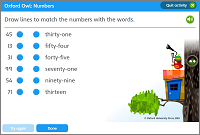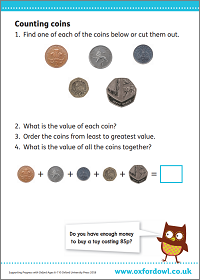Number & place value in Year 2 (age 6–7)
In Year 2, your child will learn to compare and order numbers from 1 to 100. They will recognise the place value of two-digit numbers, and will be able to use this to solve problems. They will also make more use of number lines and will be able to use less than (<), more than (>), and equals (=) symbols.
The key words for this section are number and place value.
What your child will learn
Take a look at the National Curriculum expectations for number and place value in Year 2 (ages 6–7):
Count in 2s, 3s, and 5s from 0, and in 10s from any number
They will also count in steps of 10 from any number. For example, they might count from 12: 12, 22, 32, 42, and so on. They should be able to count up and down.
Recognise the place value of two-digit numbers
For example, in ’25’, they will understand that the first number (2) shows the number of tens, and the second number (5) shows the number of ones. So there are two tens and five ones in the number 25. Note that your child will say ones and not units when talking about place value.
Your child will also understand using zero as a placeholder. For example, when writing the number seventy, we write this as 70, where 0 is used to show that there are no ones in the number.
Identify, represent, and estimate numbers shown in different ways
Your child will be expected to use objects, drawings/diagrams/pictures, number lines and 100 squares, and symbols to represent numbers. They will make these representations themselves, and will also be able to understand them when someone else has made them.
Your child will also start to estimate numbers based on different representations. For example, they will be able to say, ‘each of those piles of sticks has about 10 sticks, so we have about 30 sticks.’
Compare and order numbers from 0 to 100
Your child will be able to compare two numbers to say which one is bigger and which one is smaller. They will also be able to explain why:
47 is more than 29 as 47 has 4 tens compared with 29 which only has 2 tens.
Your child will learn to put a selection of numbers between 0 and 100 in order:
46, 19, 3, 76, 43, 79 in order from smallest to largest are 3, 19, 43, 46, 76, 79.
Your child will use the words will use the words more, less, fewer, more than, less than, equal to, equivalent to, and the same value as when comparing numbers. They will use the word fewer when working with things that can be counted, and less when working with abstract numbers and things that are continuous.
‘I have 3 fewer sweets than you.’
‘There is less water in the glass than in the bottle.’
‘25 is less than 42.’
They will also be able to use the more than (>), less than (<) and equals (=) symbols to compare numbers.
Read and write numbers up to at least 100
Your child will read and write numbers to at least 100 in numerals (1, 2, 3, and so on) as well as in words (one, two, three, and so on).
Writing out the numbers 10–20 can be particularly tricky for children, so your child might need a bit more focus on these numbers to start with.
Use place value and number facts to solve problems
‘If I have 6 apples and you have 4 apples, how many apples do we have altogether?’
To solve this problem, your child needs to understand that zero can be used as a placeholder in numbers like 10, where the ‘1’ means that there is one ten, and the ‘0’ means there are no ones.
Your child will learn number facts, which are simple number ideas that they will memorise and know straight away, such as ‘I know that 5 and 5 make 10’. This will make mental maths easier.
How to help at home
There are lots of ways you can help your child to understand number and place value. Here are just a few ideas:
1. Represent numbers creatively
Showing numbers in interesting ways really helps your child to understand number and place value. Objects from around the home like buttons, dried pasta shapes, marbles, or pencils are great to practise counting and organising numbers. For example, ’32’ could be represented by 32 marbles arranged into three groups of ten and two ones.
As well as objects, your child can use drawings, diagrams, or symbols to represent numbers. For example, you could draw 23 stick figures, then draw a circle around each group of ten, with three left outside of the circles. This shows that 23 is made from two tens and three ones.
Try drawing alongside your child, and remember, wacky drawings are more likely to capture their imagination!
Video: What is number?
Get a simple definition of the concept of number and the difference between cardinal, ordinal and nominal numbers with this fun animation.
2. Play a matching game
Your child will be expected to write numbers up to 100 using numerals and words. You could support their learning by playing a matching game.
Make two sets of simple cards or pieces of paper. On one set of cards, write numbers in numerals (for example, ’67’). On another set of cards, write the matching number names (for example, ‘sixty-seven’). Mix all the cards up and play snap.
Alternatively, you could place all the cards face down, and turn over the cards two at a time. If your child turns over two that match, they keep the cards. If they don’t match, they turn the cards back over again. This is a great memory exercise as well as a way to get to know numerals and number words.
Activity: Number words

Match the numerals to the number words.
3. Compare and order numbers
Encourage you child to talk through how they know that one number is bigger or smaller than another:
I know that 32 is smaller than 76, because 32 only has 3 tens, and 76 has 7 tens.
Encourage your child to use more than (>) and less than (<) symbols when comparing numbers. For example, they could write 32 < 76 or 76 > 32.
You could practise ordering with a card game. Write twenty two-digit numbers and the ‘>’ and ‘<‘ symbols on separate pieces of paper. Deal your child two numbers, face down. Ask them to turn over the pieces of paper and to use the ‘>’ and ‘<‘ symbols to show which number is bigger or smaller.
Now, try again with a timer! How many pairs can your child order correctly in 30 seconds?
Activity: Number statements

Drag the symbols to complete the number statements.
4. Count
When your child is counting objects, ask them to estimate how many there are before they count them. Being able to make accurate estimates within mathematics is a valuable skill we use in everyday life. It will help them to tell if their answers to maths problems are reasonable or not.
When counting more than ten objects in a set, it is an important skill for your child to be able to group objects in groups of ten. For example, if they are counting 36 buttons, encourage them to begin by counting out buttons into groups of ten. They will then have 3 groups of ten buttons and 6 buttons on their own.
It’s also helpful to practise counting in 2s, 3s, 5s, and 10s. Use objects around the house such as pairs of gloves, 2p, 5p, and 10p coins, or small bunches of grapes. Encourage your child to talk about the patterns they notice when counting in different steps (for example, the fact that numbers end in 0 or 5 when counting in steps of five).
Activity: Counting coins

Practise money and counting skills.
5. Partition numbers in different ways
Partitioning means to break numbers into parts. Use practical resources, such as straws grouped in tens, to partition numbers in different ways. For example, the number 54 can be partitioned into 50 + 4, 40 + 14, 30 + 24, 20 + 34, or 10 + 44.
This will help your child to see patterns in numbers as they develop their calculation skills.
6. Using number facts
To help reinforce your child’s understanding of number, try to find everyday opportunities for them to use known number facts to solve problems.
This is a really easy thing to do at home and in the shops. For example:
‘If we buy 7 apples and 3 bananas – how many pieces of fruit do we have altogether?’
‘If we have 10 people coming to your party and we have 5 party bags, how many more do we need to buy?’
